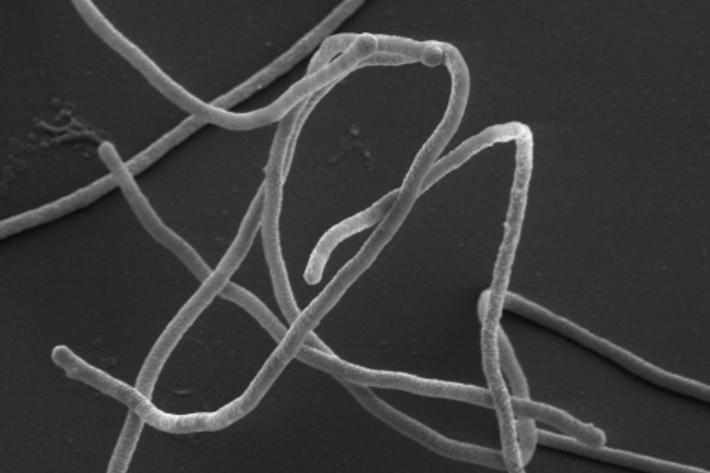A new ion channel identified in bacteria fills a missing link in the evolutionary history of ion channels in mammals

Credit: Tindall et al., 2010, Stand Genomic Sci (CC BY 2.5)
The discovery of a calcium channel that is likely a ‘missing link’ in the evolution of mammalian calcium channels has been reported today in the open-access journal eLife.
Calcium channels that open and close in response to electrical signals in the brain are essential for thought, memory and muscle contractions. Studying the structure and evolution of these calcium channels in various organisms has revealed a lot about how they work.
“Based on previous studies, scientists have predicted that the calcium channels found in mammals evolved from a bacterial ancestor, but they haven’t been able to find this missing link,” explains lead author Takushi Shimomura, Assistant Professor in the Division of Biophysics and Neurobiology, National Institute for Physiological Sciences, Japan. “Identifying this ancestor-like bacteria calcium channel is expected to help us understand the structural, functional and evolutionary relationship between bacterial and mammalian calcium channels.”
Shimomura and his team scoured the genetic sequences of bacterial voltage-gated calcium channels (CaVs) for potential ancestor-like candidates. They found one candidate called CavMr in the bacterium Meiothermus ruber. CavMr is evolutionarily distinct from other bacterial channels that have been reported.
Next, they studied what happened when they inserted mutations into the gene that encodes CavMr. Their mutational analyses indicated that the small glycine residue in the CavMr selectivity filter is an overlooked feature that determines calcium selectivity. The glycine residue is also well conserved in the selectivity filter of subdomain I and III of mammalian CaVs. These findings led the team to conclude that CavMr links calcium channels to a bacterial ancestor.
“Our work provides new insight on the universal mechanism of calcium selectivity in both mammals and bacteria,” says senior author Katsumasa Irie, Assistant Professor at the Cellular and Structural Physiology Institute, Nagoya University, Japan. “CavMr might also be useful for studies that manipulate calcium signalling to learn more about how it controls brain activity.”
Irie adds that studying the structural information of these calcium channels could provide a deeper understanding of channel evolution and help explain the origin and principles underlying calcium selectivity.
###
Reference
The paper ‘A native prokaryotic voltage-dependent calcium channel with a novel selectivity filter sequence’ can be freely accessed online at https:/
Media contact
Emily Packer, Senior Press Officer
eLife
[email protected]
01223 855373
About eLife
eLife is a non-profit organisation inspired by research funders and led by scientists. Our mission is to help scientists accelerate discovery by operating a platform for research communication that encourages and recognises the most responsible behaviours in science. We publish important research in all areas of the life and biomedical sciences, including Biochemistry and Chemical Biology, and Structural Biology and Molecular Biophysics, which is selected and evaluated by working scientists and made freely available online without delay. eLife also invests in innovation through open-source tool development to accelerate research communication and discovery. Our work is guided by the communities we serve. eLife is supported by the Howard Hughes Medical Institute, the Max Planck Society, the Wellcome Trust and the Knut and Alice Wallenberg Foundation. Learn more at https:/
To read the latest Biochemistry and Chemical Biology research published in eLife, visit https:/
And for the latest in Structural Biology and Molecular Biophysics, see https:/
Media Contact
Emily Packer
[email protected]
Original Source
https:/
Related Journal Article
http://dx.




